St. Paul residents gaze at their homes in 1942 as the US Army Transport Delarof pulls away from the dock, taking them to internment camps in southeast Alaska. Courtesy of the National Archives and Records Administration.
In October 1943, while Americans prepared for another year of rationing and sacrifices for the war effort, Dr. Berneta Block, a representative from the United States Department of Health, was dispatched to Alaska to investigate the living conditions of the 800 indigenous Unangan (Aleuts) from the Aleutian Islands. The Unangan had been evacuated from their homes following the Japanese bombing of Dutch Harbor and invasion of the Attu and Kiska Islands in June 1942. Censorship of events in Alaska during the Aleutian Islands campaign prevented few details of their removal and subsequent internment overseen by the Department of the Interior, the Office of Indian Affairs, and the Fish and Wildlife Service, and certainly no Americans were privy to the despair that Block encountered during her visit.
Block arrived expecting to assess an outbreak of measles among the Unangan from the Pribilof Islands of St. George and St. Peter held at a former fish cannery at Funter Bay on Admiralty Island but, instead, found the circumstances the Unangan were forced into by the US government worse than she imagined. Once she entered the first bunkhouse where multiple families shared only two or three rooms quartered off with grimy bed sheets for makeshift dividing walls, her horror overwhelmed her. “As we entered the first bunkhouse, the odor of human excreta and waste was so pungent that I could hardly make the grade,” she noted. She and the other investigators laid their eyes upon mothers and children who shared single bunkbeds, huddled together in the damp cold and darkness, and found other children “naked and covered with excreta.” No proper sewage system existed for the inhabitants and the only water supply from a nearby creek was “discolored” and polluted. As another official noted, no living being should be forced to inhabit these conditions.
Evacuation and internment during World War II is remembered by the Unangan today, but this moment exists on the margins of America’s collective wartime history. Their experiences at the hands of a disorganized and poorly executed operation and their struggles to survive and maintain their dignity when faced with such tragedy, however, deserve a prominent place in the history of the American home front and the Pacific Theater of the war alongside the more well-known removal and incarceration of Japanese Americans from the mainland West Coast.

An Unangan family (possibly celebrating a wedding) from St. Paul Island, 1920s. Photographer G. Dallas Hanna. Courtesy of the National Archives and Records Administration.
The roots of the wartime internment of the Unangan can be found in Alaska’s territorial relationship with the United States. When purchased from the Russians in 1867, the federal government declared all indigenous peoples of the new territory to be American citizens, but the Department of the Interior (DOI) assumed authority over the Unangan, making them “Indian wards” of the United States. No formal reservation system existed in the Alaskan territory, but the Office of Indian Affairs (OIA) oversaw the livelihoods of the Unangan. The Fish and Wildlife Service (FWS) controlled the employment of Unangan who lived on the Pribilof Islands and made their living hunting fur seals.
Along with the presence of the OIA and the FWS, the military played a role in the settlement and administration of Alaskan territory. The Army maintained order and oversaw the construction of forts from 1867 through 1877 while the Coast Guard enforced seal hunting treaties among the United States, Japan, Britain, and Canada after 1915.
With tensions rising in Pacific during the 1930s, the Army strengthened its presence in the “outposts” of Hawaii and Alaska. By June 1940, the Army had ordered 5,000 troops to Alaska. As the War Department began to see the Aleutian Islands as “stepping stones” for a potential Japanese foothold in Alaska, garrisoning of the territory increased through the summer and fall of 1941 following the creation of the Alaskan Defense Command. The strategic importance of the Unimak Straight that connected the Bering Sea to the Pacific prompted the construction of a naval base in July of 1940 at Dutch Harbor and later an Army airfield at the same location. As the military importance of the Alaska Territory increased, more settlers from the “lower 48” arrived in the Aleutian Islands for construction jobs and added to a population boom in the region, but it would be the attack on Pearl Harbor that would forever alter the lives of the Unangan.
Brigadier General Simon Bolivar Buckner (leader of the Alaska Defense Command) and the War Department’s warnings of impending Japanese hostilities would come to fruition in the late spring of 1942 with the beginning of the Aleutian Islands Campaign. On June 3, the Japanese bombed Dutch Harbor naval installations and attacked Army facilities at Fort Mears the following day. On June 6, Japanese invaded and occupied Kiska Island where all ten Navy personnel defending the island were taken prisoner. The following day, the Japanese forcibly landed at Holtz Bay on Attu Island where they took 42 Unangan as prisoners, holding them in a schoolhouse for interrogation.
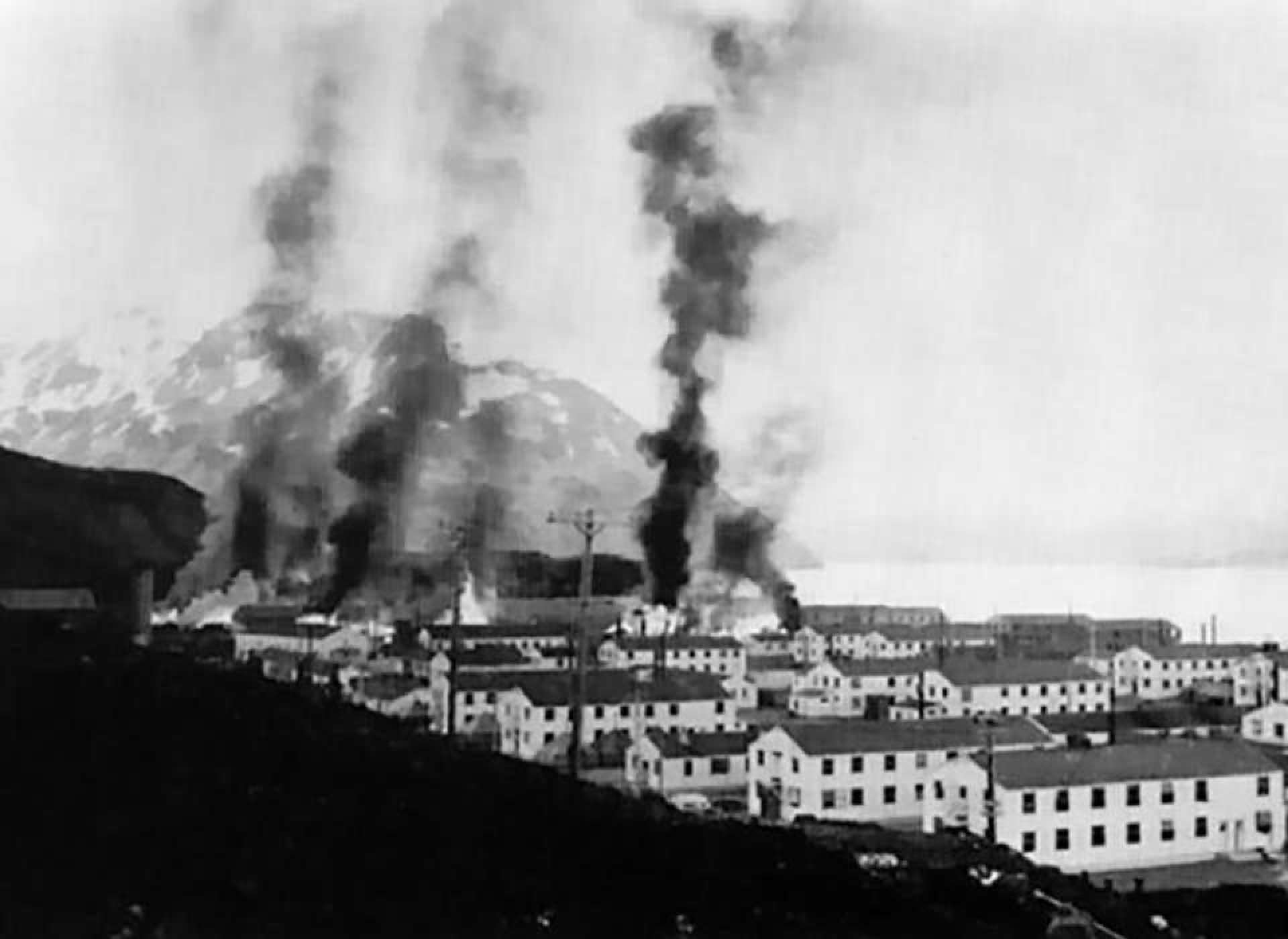
Barracks buildings at For Mears burn following the Japanese attack on June 3, 1942. Courtesy of the National Archives and Records Administration.
Following the Japanese attacks, American government and military officials scrambled to determine what to do with the Unangan who lived in a now-active war zone. Attempts at planning for measures in the event of an attack began well before the Aleutian Islands campaign. In early 1942, the Army and Navy agreed that Unangan women and children should be evacuated along with white women and children who lived in Unalaska (the largest city in the Aleutian Islands and located on Dutch Harbor) in case of a military threat and that plans for evacuation should be coordinated with the Territorial Governor of Alaska (which was under the DOI’s jurisdiction), but not all civilian leaders came to the same conclusion.
Commissioner of the OIA, John Collier, did not want to forcibly remove Unangan in the event of an attack. He also, however, did not want to have them remain in a dangerous area. As Collier pointed out to Secretary of the Interior Harold Ickes, if the Japanese bombed Dutch Harbor and Unangan were harmed, then the DOI would be criticized for their lack of care. The OIA decided to leave evacuation plans to Rear Admiral Charles S. Freeman of the Navy who had no desire to take over planning for the evacuation itself. Alaska Territorial Governor Ernest Henry Gruening was also opposed to forced evacuation as he believed that the “dislocation resulting from a forced evacuation would be a greater damage and involve greater risks to the ultimate welfare of the people than the probably risks if they remain where they are.”
A comprehensive plan for evacuation was non-existent and civilian agencies and the military were uncoordinated. The Department of the Interior could not internally reach an agreement on how to organize an evacuation, while the Navy rejected any decision-making responsibilities for the process. General Buckner believed that it would be “a great mistake” to evacuate all Unangan beyond Unalaska as “evacuating them would be pretty close to destroying them, that they now live under conditions suitable to them” and they would “deteriorate” if they encountered “the white man…[and] fall prey to drink and diseases.”
Governor Gruening advocated that the Unangan of Attu and Atka should be consulted on evacuation after an attack. Gruening shared Buckner’s concerns but wanted the Unangan to fully understand what an evacuation would mean and suggested, “Before any decision could be made, a qualified representative of the Office of Indian Affairs [should] proceed to Attu and Atka…to discuss the matter fully with the natives and make the appropriate recommendations.”
Unfortunately, the attacks on the Aleutians made Gruening’s proposed solution obsolete. On June 11, 1942, the Navy launched air raids on the Japanese at Attu, and Freeman issued orders for the evacuation of the Unangan as well as an order to burn homes and property to prevent their being used in any capacity by the Japanese. Prior to the June attacks, the Unangan of Atka were ready to evacuate on their own accord but without a clearly-identified military or civilian group to coordinate with (President Franklin Roosevelt signed Executive Order 9181 on July 11 creating the Alaska War Council for civil-military cooperation in Alaskan defense) they instead rushed from their burning homes with few of their possessions.
On June 16, the US Army Transport Delarof arrived at the Pribilof Islands of St. George and St. Paul to evacuate Unangan residents and FWS employees. The Army notified the FWS employees on June 14 to grab what possessions they could and to prepare “the village for destruction by placing a pail of gasoline in each house and building and a charge of dynamite for each other installation such as storage tanks, light plants, trucks, radio transmitters, receivers, antenna, masts.” Every individual was allowed nothing more than one suitcase and a roll of blankets to bring along with them when the ship departed.
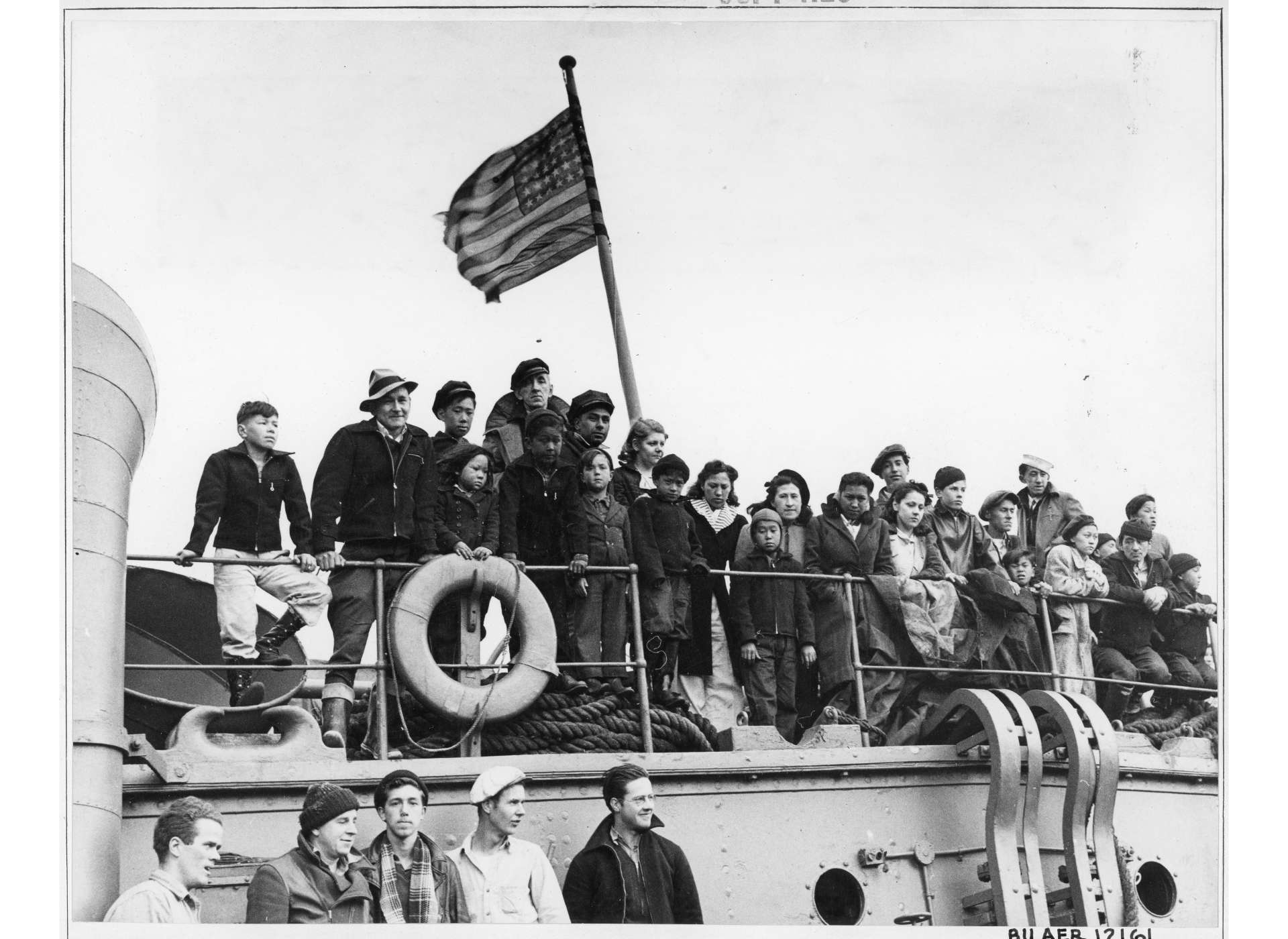
Unangan evacuees aboard the Delarof, June 1942. Courtesy of the National Archives and Records Administration.
On June 17, with 477 Unganan from the Pribilof Islands and 22 FWS employees aboard, the Delarof arrived at Dutch Harbor to pick up 81 Unangan from Unalaska before setting sail again on June 18 to unknown destinations. While onboard the crowded and unsanitary Delarof a baby Unangan girl from St. George died of pneumonia. With few medical sources to assist the child, her heart-broken mother and those aboard the ship had no choice but to organize a small funeral for the “poor little mite, such a tiny weighted parcel being let down into the deep waters of the Gulf of Alaska against a shoreline of dramatic peaks and blazing sunset sky.”
While the Delarof sailed, the DOI scrambled to find locations for the evacuees. Planning and the selection of sites did not formally begin until June 15—while evacuation was already underway. Sensing an impending crisis, General Buckner worked with the OIA to search for camp sites. They first considered locations in and around Seattle (including the Tulalip Indian Reservation and a Civilian Conservation Corps camp), but these solutions were logistically impractical.
Ultimately, the OIA decided that the Unangan should remain in southeastern Alaska and that those from the same village should stay together. The OIA was also interested in selecting sites where the Unangan could be self-sufficient through their own labor. On June 16, the OIA planned with FWS agents to hold Unangan from Atka in an old fish cannery in Killisnoo on Admiralty Island and those from the Pribilof Islands at another cannery at Funter Bay on the same island.
Following the initial removal of Unangan from the Pribilofs and Unalaska and its immediate areas, Admiral Freemen ordered on June 29, 1942 that “all natives from the Aleutian islands” were to be evacuated following the Alaska War Council’s fears that more of Unangan villages were at risk. General Buckner disagreed with the Council’s proclamation, but assisted Freeman and the Navy with the evacuation of the remaining Unangan villages from July 12 through July 26 with the assistance of the DOI. The remaining Unangan went aboard vessels operated by the Alaska Steamship Company to the Wrangell Institute (a OIA-operated boarding school) until facilities at the Ward Lake Civilian Conservation Corps camp just north of Ketchikan and the Burnett Inlet cannery near Wrangell were ready for inhabitants. After the evacuation of Unalaska, Admiral Freemen declared that no further removal was necessary.
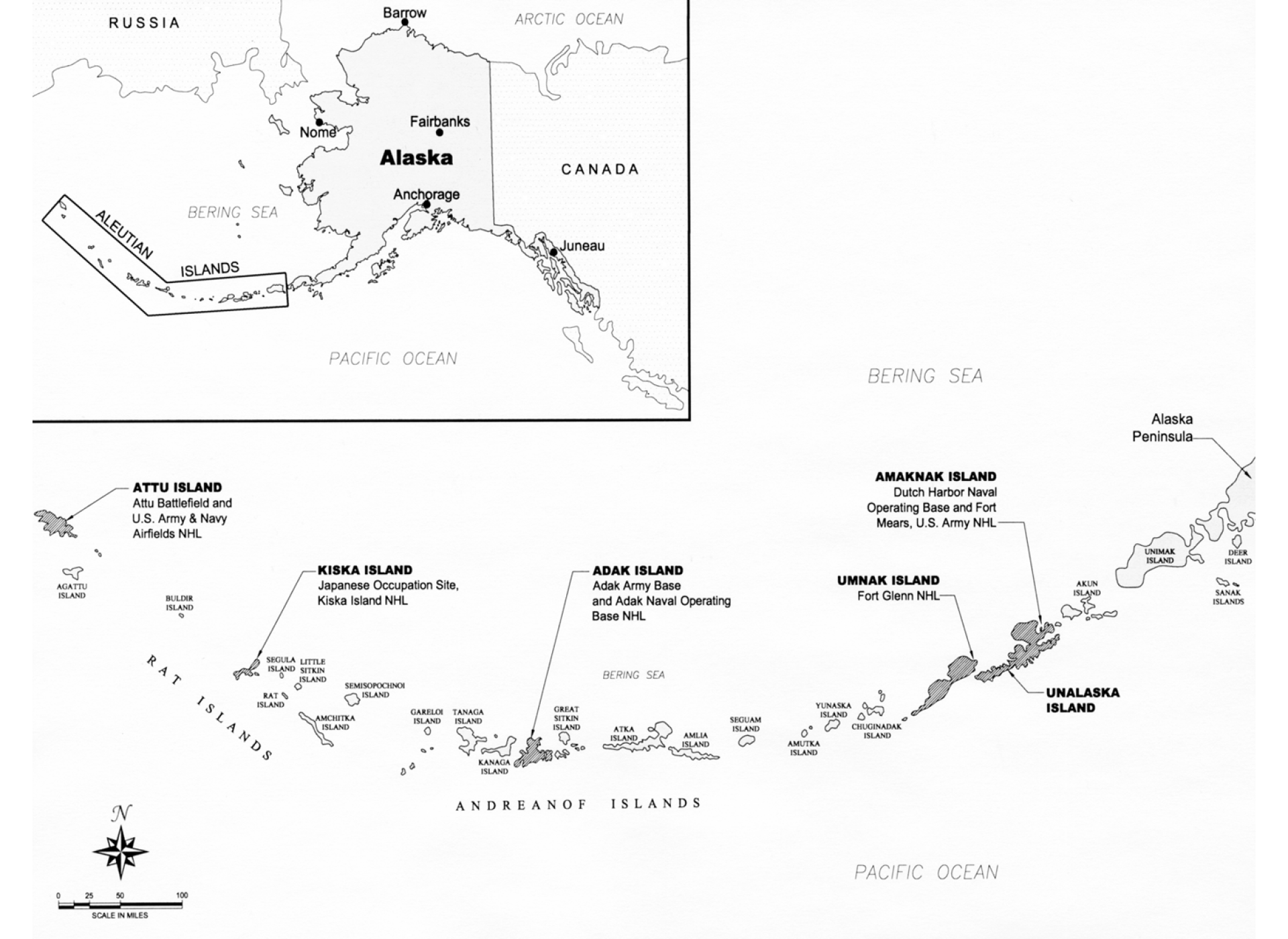
Map of the Aleutian Islands chain. Courtesy of the National Park Service.
In some places like Unalaska that had a more diverse population as one of the larger cities in the Aleutians, white residents were permitted to remain in their homes while the Navy gave Unangan residents a day’s notice to gather their possessions in preparation for removal. The captain of the Dutch Harbor Naval Station, Commander William N. Updegraf, issued the following evacuation order for Unalaska on July 19:
All natives or persons with as much as one eighth native blood were compelled to go…Only such portable baggage as the people could carry was permitted…No employee, native or white, of Siems-Drake Puget Sound Company [a contractor responsible for military and naval construction work] was to be carried.
While both white and Unangan employees were needed for war-vital work at Siems-Drake, records reveal that because Ickes requested the order, Updegraf interpreted it as only applying to Unangan because of the OIA connection and the fact that most “duration camps” were created and established by the OIA. However, Unalaska residents not of Unangan descent were not required to evacuate to other areas or facilities not overseen by the OIA.
Unangan who were held in one of the five “duration camps” operated by the OIA faced miserable circumstances. They lived in dilapidated structures with inadequate healthcare while enduring harsh weather. The 300 Unangan at Funter Bay lived in two dormitory-style buildings at an old fish cannery where six to 13 people slept in areas that were roughly 10 square feet. Inhabitants often fell through rotten wood floors, shared one toilet for all 300 residents, and washed their clothes on the ground with buckets of dirty water. Not far away at the Funter Bay mine, the 180 Aleuts from St. George lived in “crowded, dark, and unheated quarters” and epidemics like tuberculosis and the flu ravaged the population (killing at least 40 of the 180) left to the care of only one nurse.
Unangan women at Funter Bay wrote a petition to the OIA in October 1942, protesting their living conditions.
“We the people of this place wants[sic] a better place to live,” the petition began. “We drink impure water and then get sick…We got no place to take a bath and no place to wash our clothes or dry them when it rains…we live in a room with our children just enout to turn around in. We use blankets for walls just to live in private.”
Unangan men were encouraged to either work at the cannery doing odd jobs or, when granted permission by the War Department in January 1943, return to the Pribilof Islands to continue the fur seal hunt. For their labor, they received only $20 a month, “which [was] nothing to them” and not enough to purchase clothing or additional food from camp stores.
In response, the OIA dismissed the women’s concerns, telling them that “under war conditions, they could not expect to enjoy the comforts and conditions as they existed on the Pribilof Islands.” The OIA later admitted in a report, however, that “ the water [is] potentially unsafe” and that children suffer from “fish poisoning,” probably caused by eating contaminated salmon.
Conditions at the other camps were sometimes better, though not without their challenges. Evacuees lived in cold, drafty, and dirty warehouses in Burnett Inlet and the OIA expected them to refurbish other buildings themselves for schools, areas of worship, and health facilities. Women struggled to serve as midwives with limited medical supplies. Illness and disease were persistent problems in close quarters at all the camps, and homesickness, concern over remaining possessions that were left behind, fears of another Japanese attack, and uncertainty over what came next were mentally exhausting for the Unangan.
The Aleuts continued to live at the camps until preparation for return began in the fall of 1943. Fearing another harsh winter with limited supplies for the camps, the DOI negotiated with the War Department and the Navy for funds to begin the return of the Unangan to their homes once cleared by the Army. While the FWS oversaw the return of Unangan men to the Pribilof Islands for the seal hunt, the Army and Navy left the resettlement logistics once again to the OIA and contributed funding for the process. In August 1944, President Roosevelt also dedicated $400,000 for the “restoration, repair, reconstruction and equipment of public and private buildings and other property” on the Aleutian and Pribilof Islands as well as the “subsistence of the Aleuts.” But continued disagreements among the various branches of the military and the civilian agencies responsible for the care of the Unangan meant that no one wanted to administer the project, and no Unangan returned to their homes until April 17, 1945.
After their trying experiences in the camps, the Unangan were heartbroken by what awaited them upon their return. Members of the Army who had occupied dwellings that were not destroyed in preparation for a Japanese invasion well as civilians who were allowed to remain for defense purposes treated Unangan property with little respect. Reports from the OIA revealed that
“all buildings were damaged due to lack of normal care and upkeep…inspections revealed extensive evidence of widespread wanton destruction of property and vandalism…contents of closed packing boxes, trunks, and cupboards had been ransacked, clothing had been scattered over floors, trampled and fouled, dishes, furniture, stoves, radios, phonographs, books, and other items had been broken or damaged.”
Others reported that items that registered in official inventories before evacuation were simply “missing.” When he returned home to Unalaska, Sergie Savaroff found that his new coal range he purchased before evacuating had disappeared. Eventually, it was “found at an officers’ quarters in Umnak,” about 80 miles away. In other cases, inhabitants returned to nothing: their homes and property were scorched by the military in preparation for an impending Japanese invasion.
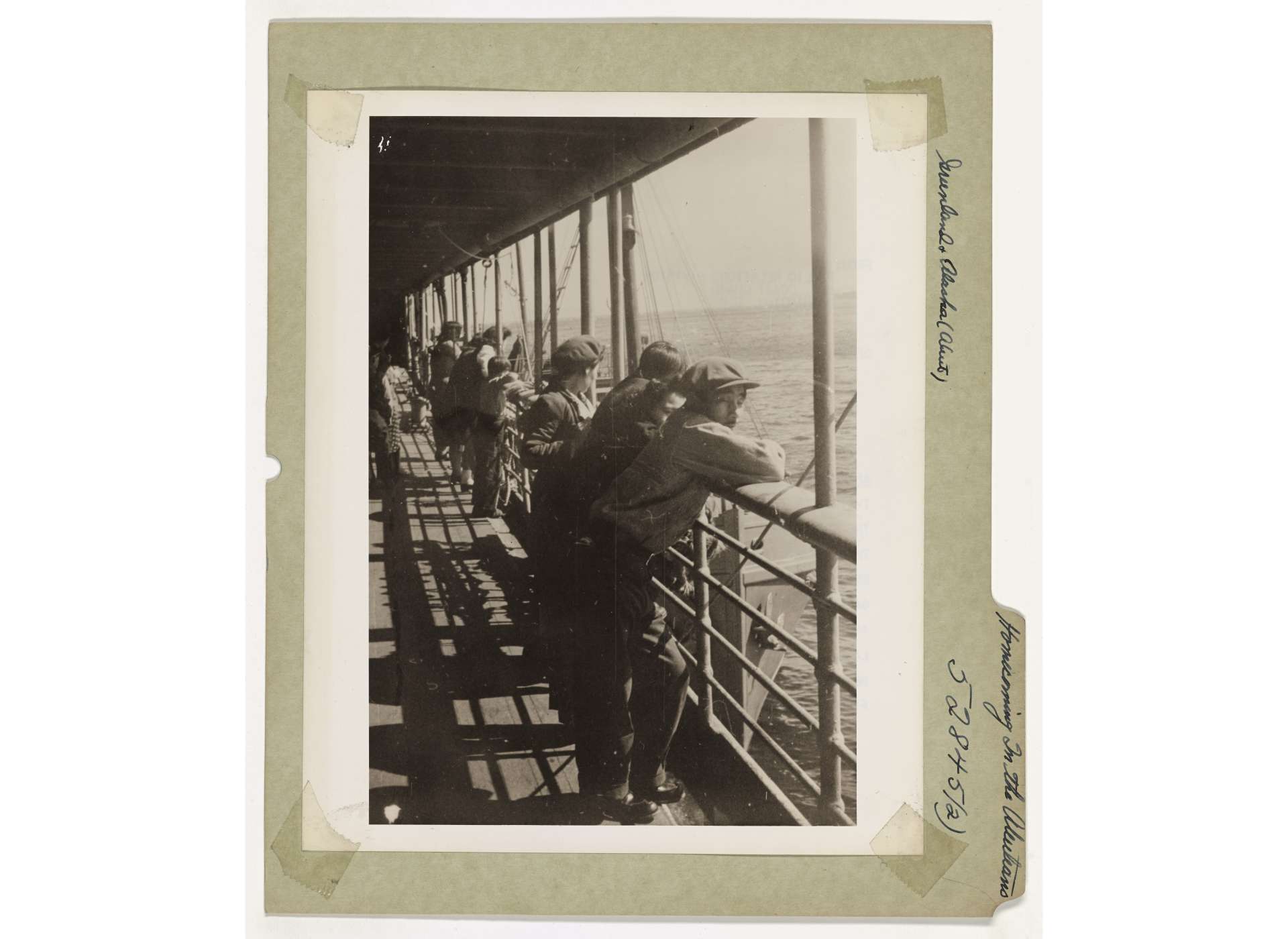
A group of Unangan men watch as they near St. Paul Island, their first glimpse of home after removal for nearly three years, May 28, 1945. Courtesy of the National Archives and Records Administration.
The bumbled removal and subsequent internment were devastating for Unangan communities. Many elders who carried cherished traditions perished amidst harsh living conditions while the psychological trauma of time at the camps never ended for others. Priceless artifacts and culturally significant items relating to worship and Russian Orthodox Christianity (practiced by many Unangan) were forever lost. Some villages including Biorka, Kashega, Makushin, and Attu (the Japanese held residents of Attu as prisoners) were looted and destroyed by Japanese and American forces and never resettled. Congress passed the Aleutian and Pribilof Islands Restitution Act in 1988 to recognize the suffering of the Unangan during the war, but the $12,000 received by the survivors did little to compensate for their tangible and intangible loss.
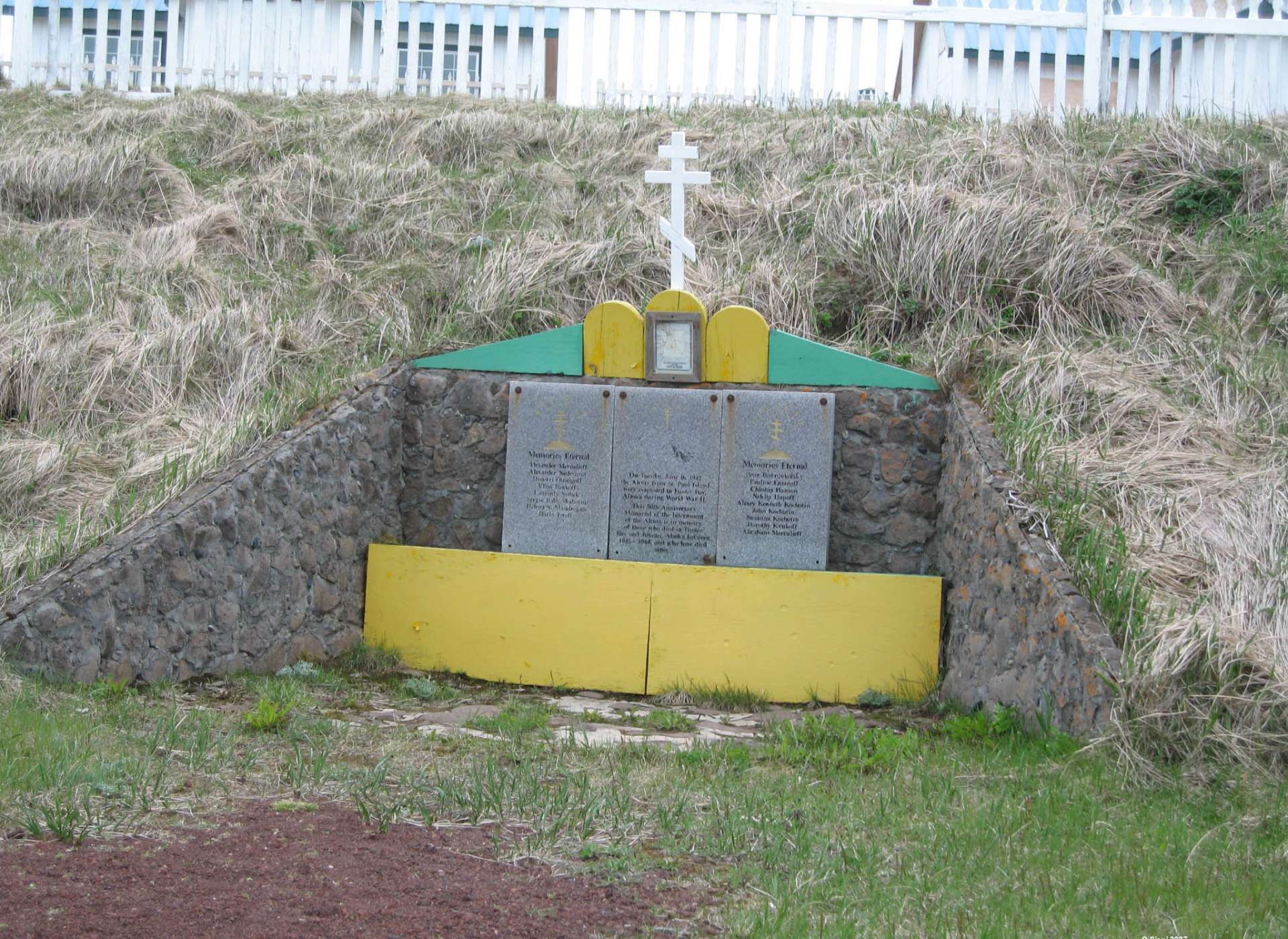
50th Anniversary Memorial of the internment of Unangan during World War II located on St. Paul Island at Saints Peter and Paul Russian Orthodox Church. Photographer Jim Haklar. Courtesy of the National Archives and Records Administration.
Today, however, scholars and community activists continue to give voice to this moment in American history. The National Park Service and Aleutian Pribilof Heritage Group have worked together on an archeological project uncovering aspects of life at the camps while historian Dr. Holly Miowak Guise, an Inupiaq Alaska Native, documents not only the experiences of the Unangan in the camps but also captures the oral histories of native Alaskans who served in the military during World War II. This story of tragedy and survival is an integral part of the history of the Pacific theater of the War and a testament to the strength of the Unangan community.
Stephanie Hinnershitz, PhD
Stephanie Hinnershitz is a historian of twentieth century US history with a focus on the Home Front and civil-military relations during World War II.
Cite this article:
MLA Citation:
APA Citation:
Chicago Style Citation:
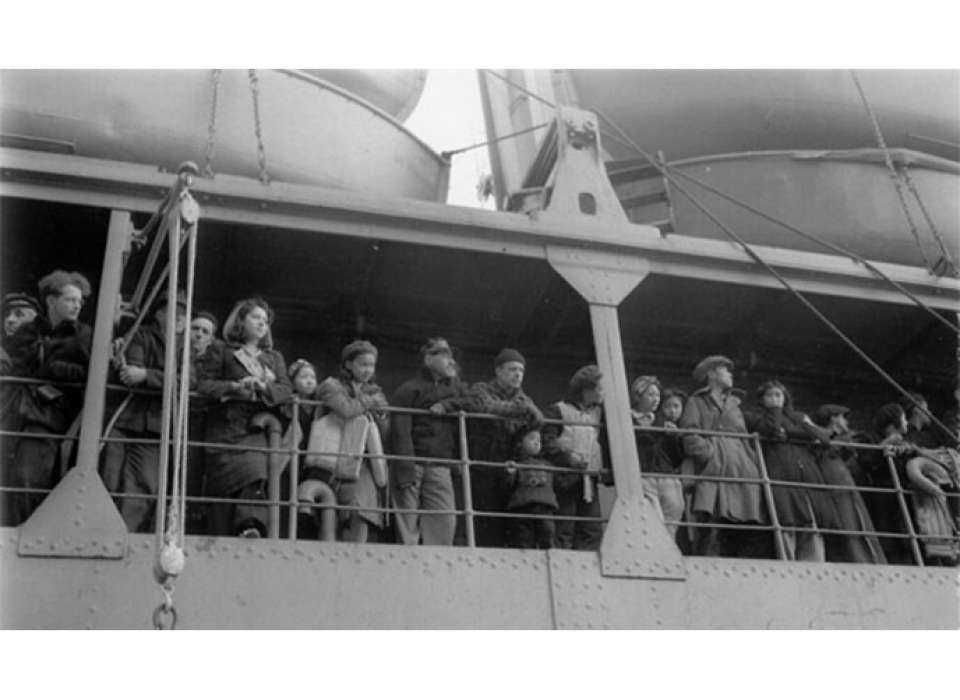







![Max Fuchs, New York City cantor, sings as Rabbi Sydney [sic] Lefkowitz, Richmond, VA, conducts the first Jewish services from Germany.](/sites/default/files/styles/max_650x650/public/2025-10/image1.jpg)
